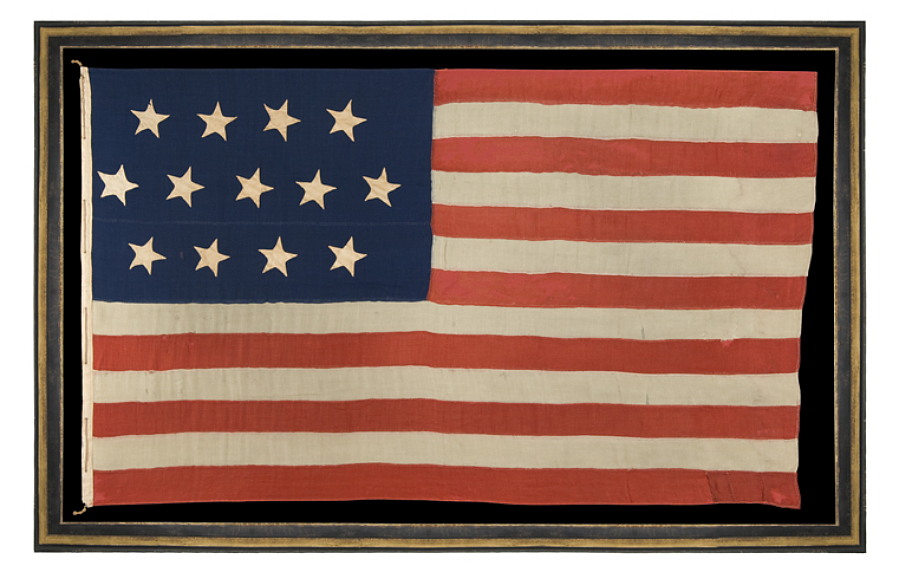
| |
ENTIRELY HAND-SEWN , 13 STAR US NAVY SMALL BOAT ENSIGN IN THE 4-5-4 PATTERN, CA 1850-1863 |
|
| Available: |
Sold |
| Frame Size (H x L): |
62.5" x 98.5" |
| Flag Size (H x L): |
51" x 89" |
|
| Description....: |
|
ENTIRELY HAND-SEWN, 13 STAR, U.S. NAVY SMALL BOAT ENSIGN IN A 4-5-4 CONFIGURATION, MADE SOMETIME BETWEEN 1850 AND THE OPENING YEARS OF THE CIVIL WAR (1861-63):
Entirely hand-sewn, 13 star American national flag. This is a U.S. Navy small boat ensign, made sometime between 1850 and the opening years of the Civil War (1861-1863); probably the latter, since production increased with the need driven by war. Small boat ensigns were sometimes flown at the stern, from a gaff, or from the yard-arm on a larger vessel, or as the primary flag on a skiff or other small craft that carried sailors back and forth to shore.
The 4-5-4 row configuration is both scarcer and more appealing than rows of stars in counts of 3-2-3-2-3, and is generally seen on flags made during the Civil War period and prior. For some reason the 4-5-4 pattern was not popular during the celebration of our nation's 100-year anniversary in 1876 or thereafter, so it is both desired and more interesting than some other 13 star designs. It is sometimes seen in the 1890's on small 13 star flags made for use on private yachts, but these are scarce. Most private yacht flags carried different designs.
This is an unusually large example among small boat ensigns with 13 stars. The most common variety measures approximately six feet in length. This particular flag was most certainly longer in length originally. The original proportions would have been more elongated, which was customary in Naval flags, so that the fly end could be turned back and hemmed to repair losses and thus extend their use.
13 star flags have been used throughout our Nation's history for a variety of purposes. The U.S. Navy used the 13 star count on small boats, not only in the 18th century, but throughout much or all of the 19th century, particularly the second half. Ship captains were paranoid about the ability of foreign ships to recognize the flag on the open seas. On small flags in particular, viewed through a spyglass at a distance, the ability discern individual stars was a concern. Keeping the count at 13 maintained better visibility and consistency. The practice theoretically ended in 1916 following an executive order from then-President Woodrow Wilson, though old military traditions die hard and according to at least one expert, Wilson's order did not completely dispel the presence of 13 star flags on U.S. Navy craft.
Some private ships flew 13 star flags during the same period as the Navy, and the use of yachting ensigns with a wreath of 13 stars surrounding an anchor, which began in 1848, still persists today. Among other uses, 13 star flags were carried by soldiers during the Mexican and Civil Wars and displayed at various patriotic events, including Lafayette's final visit to the U.S. in 1825-26, the celebration of the Nation's centennial of independence in 1876, and the sesquicentennial in 1926.
Construction: The flag is entirely hand-sewn. The canton and stripes are made of wool bunting. The stars are made of cotton and are double-appliqued (applied to both sides of the canton). There is a coarse linen binding, through which a series of small metal rivets were inserted at regular intervals, through which a hemp rope has been threaded for hoisting.
Mounting: The flag has been hand-stitched to 100% silk organza for support on every seam and throughout the star field. The flag was then hand-stitched to a background of 100% cotton, black in color. The background fabric was washed to remove excess dye. An acid-free agent was added to the wash to further set the dye, and the fabric was heat-treated for the same purpose. The mount was then placed in a black-painted, hand-gilded and distressed Italian molding. The front is U.V. protective acrylic.
Condition: There is minor to significant wear throughout, most prevalent along the top stripe. There is minor to moderate mothing throughout, accompanied by minor foxing and staining. There is a period patch on the bottom stripe at the fly end. The fly end was turned back and hemmed during the course of its use. 100% natural fabrics were placed behind the flag during the mounting process, both for masking purposes and to strengthen the color against the black background. Many of my clients prefer early flags to show their age and history of use. |
|
|
|
| Collector Level: |
Advanced Collectors and the Person with Everything |
|
| Flag Type: |
Sewn flag |
|
| Star Count: |
13 |
|
| Earliest Date of Origin: |
1850 |
|
| Latest Date of Origin: |
1863 |
|
| State/Affiliation: |
13 Original Colonies |
|
| War Association: |
1861-1865 Civil War |
|
| Price: |
SOLD |
|
| |
Views: 3159 |
|
|
|

